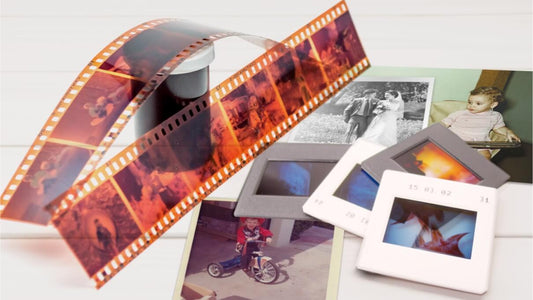Trying to send a video through email can be frustrating, especially when you’re met with the “file too large” error. Whether it’s a family memory, a school project, or a work file, many people run into this issue when trying to share videos. Common solutions like trimming or compressing the file can help, but they’re not always enough—or they take too long when time matters most. Fortunately, there are smarter and more reliable ways to get it done. With the right steps and tools, including services like Capture, it’s easier than ever to send a video through email quickly and without hassle.
Jump to:
- Why Videos and Emails Don't Mix Well
- 4 Ways to Share Large Videos via Email
- How to Troubleshoot Common Issues When Sending Videos via Email
- Send It Your Way
Why Videos and Emails Don't Mix Well
Email systems were originally designed for text-based communication, not for handling large media files like videos. This fundamental mismatch creates a significant challenge when trying to share your precious moments via email.

Most email providers impose strict size limits on attachments to manage server space and ensure efficient delivery. These limits typically range from 20 to 25 megabytes, which is often insufficient for modern video files. So can you send video through email? Yes, but not always as a direct attachment. Alternative methods are often required.
To put this into perspective, here's a quick reference guide for typical smartphone video file sizes:
|
Video Length |
Approximate File Size |
|---|---|
|
<1 minute |
40-300 MB |
|
2-5 minutes |
200 MB - 1.5 GB |
|
>5 minutes |
1 GB - 5 GB or more |
Note: These sizes are estimates for videos recorded at 1080p (Full HD) resolution. 4K videos will be significantly larger.
As you can see, even a short one-minute video can easily exceed the attachment limits of most email services. For comparison, here are the attachment limits for some popular email providers:
- Gmail: 25 MB attachment limit
- Outlook: 20 MB attachment limit
- Yahoo Mail: 25 MB attachment limit
It's worth noting that while these are the attachment limits, some providers offer expanded storage options. For instance, Gmail and Outlook users have access to 15 GB of total storage through Google Drive and OneDrive respectively, which can be used for larger file sharing.
4 Ways to Share Large Videos via Email
Since email providers typically limit the size of attachments, sending large video files can be challenging. But don’t worry, there are several ways to get around these file limits and figure out how to send a large video through email without losing quality:
1. Compress the Video
Compressing a video means shrinking its file size so that it’s easier to send through email or other platforms with size limits. Although this may slightly affect its quality, modern compression tools do a great job of balancing file size and visual clarity. This is especially useful when figuring out the best way to share videos via email for both personal and professional use. There are several tools available to help with this.
VEED.IO
VEED.IO is an intuitive tool for reducing video sizes while keeping the quality intact. It helps you save storage space and makes uploads faster. Plus, you can edit your videos right in the platform—adding subtitles, trimming, and more.
How to compress with VEED.io:
- Upload your video by either dragging it in or recording directly.
- Choose the compression settings yourself, or let VEED find the best balance between size and quality for you.
- Once compressed, you can export the file or continue editing with its full range of tools.
InVideo
InVideo is great for compressing videos in multiple formats like MP4, MOV, and more. It allows you to compress videos by up to 80% without losing too much quality. InVideo is perfect for quick compression with no need to sign up.
How to compress with InVideo:
- Upload your video file (up to 800MB).4
- Select your preferred compression quality—higher compression will reduce the size more but may affect quality slightly.
- Download the compressed file, and you’re ready to share it.
Riverside.fm
Riverside.fm lets you reduce file sizes without making things complicated. It’s fast and free, and it works well for keeping quality intact.
How to compress with Riverside.fm:
- Upload your video to the platform.
- Set your compression preferences and apply the changes.
- Once it’s ready, download the compressed file, and you’re all set.

2. Use Cloud Storage
Cloud storage is another great solution for sending large video files via email. It involves uploading your video to a cloud hosting site and generating a shareable link. You can then insert this link into the body of the email to share your video with the recipient. This method not only bypasses size limits but also keeps your email clean and ensures faster delivery. If you’re wondering how to send a video through email from phone, cloud storage apps like Google Drive and Dropbox make it possible from almost any device.
Google Drive
Google Drive offers 15 GB of free storage and works seamlessly with Gmail. Uploading and sharing videos is straightforward. Once your video is uploaded, you can right-click the file to generate a shareable link or adjust the sharing settings to control who can view or download the content. It's a convenient option for sending videos of all sizes, especially if you're already using other Google services. Plus, recipients don’t need a Google account to view the video - you can allow access with just the link.
Dropbox
Dropbox is known for its simplicity and cross-device compatibility. It provides 2 GB of free storage and is great for those who need a quick and user-friendly way to share videos. Here's how you can use it:
- Log in to dropbox: Sign in via the website or app.
- Upload your video: Click the "Upload" button, select "Files," and choose your video. Dropbox allows you to drag and drop files, making the process simple.
- Generate a shareable link: After uploading, hover over the video, click "Share," and Dropbox will create a link for you.
- Send the link: Paste the link into an email or message for quick sharing. No Dropbox account is required for the recipient to view the video.
OneDrive
If you’re a Windows user, OneDrive is likely already integrated into your workflow. With 5 GB of free storage, it’s a natural choice for those working within the Microsoft system. Here’s how you can use it:
- Log in to OneDrive: Access it through your Microsoft account on the web or mobile app.
- Upload your video: Click "Upload" and select the video file, or simply drag and drop it into OneDrive.
- Create a shareable link: Once uploaded, right-click the video, select "Share," and adjust the access permissions as needed.
- Share the link: Copy and paste the link into your email or message. The recipient can stream or download the video without needing a OneDrive account.
iCloud
For Apple users, iCloud provides a built-in option for sharing videos without size restrictions. It’s perfect for those who are already using iOS or macOS devices. Here’s how iCloud works for video sharing:
- Access iCloud Drive: This service is built directly into your iPhone, iPad, or Mac, so no need to download anything extra.
- Upload your video: Head to iCloud Drive and upload your video.
- Generate a share link: Once your video is uploaded, right-click and select "Share." You can adjust permissions to control who can access the file.
- Send the link: Share the link via email or message. The recipient can view the video even if they don’t have an iCloud account.
3. Use Video Sharing Platforms
Video-sharing sites make it easy to send large video files by simply sharing a link. You upload your video in formats like MP4, MOV, or AVI, and the platform takes care of the rest. This eliminates email attachment issues and allows for easy streaming. Some people even use platforms like YouTube to share content they’ve converted from analog- like when they transfer VHS to digital for easier distribution.
YouTube
YouTube is perfect when you want to share your videos with a wide audience. It's free, easy to use, and everyone knows how it works. Your friends and family can watch your videos on their phones, computers, or even smart TVs without any fuss. To send a YouTube video via email:
- Go to YouTube.com and log in using your Google account.
- Click the camera icon at the top right and select "Upload Video."
- Choose the video from your device and set your privacy options (Public, Unlisted, or Private).
- Once uploaded, click "Share" to get the video link.
- Paste the link into your email and send it.
Vimeo
Vimeo is ideal if you want your videos to have a more polished look. It's ad-free, so your viewers won't get distracted by commercials. While not as well-known as YouTube, Vimeo is great for sharing higher-quality videos with a select group of people. To send a Vimeo video via email:
To send a Vimeo video via email:
- Go to Vimeo.com and log in to your account.
- Click "New Video" and choose "Upload" to select your video.
- Set your privacy settings (Anyone, Only me, or People with a private link).
- After uploading, copy the private link under the video player.
- Paste the link into your email and send it.

4. Use File Transfer Services
The last way to send large video files is to use file transfer services. These tools let you upload your video, generate a download link, and share it via email. They’re ideal for quick, one-time transfers and don’t usually require an account. They're also helpful if you're working with digitized older formats, like when you convert 8mm video cassette to digital and need a simple way to share it with others.
WeTransfer
WeTransfer is a widely used file transfer service that allows you to send up to 2 GB of files for free. You don’t need to create an account—just upload your video, enter the recipient’s email, and hit send. The recipient will get a download link that stays active for seven days, making it a quick and convenient option for short-term sharing.
Steps to use WeTransfer:
- Visit the WeTransfer website.
- Upload your video file.
- Enter the recipient’s email address.
- Click “Transfer” to send the file.
- Copy the shareable link once the upload is complete and paste it into your email.
Send Anywhere
Send Anywhere offers a more secure option by generating a unique 6-digit key that the recipient must enter to access the file. This adds an extra layer of privacy, especially when sharing personal or sensitive videos. You can also send files via email or a direct link, and the service supports large file sizes and a wide range of devices.
Steps to use Send Anywhere:
- Visit the Send Anywhere website.
- Upload your video file.
- Generate a unique 6-digit key.
- Send the key and link to the recipient via email.
- The recipient enters the key to access and download the video.
How to Troubleshoot Common Issues When Sending Videos via Email
Sometimes, even after following all the right steps, your video still won’t go through. Whether it's a compatibility issue or a slow connection, these common problems can usually be fixed with a few simple solutions:
Fix Unsupported Video Formats
One major issue is using a video format that isn’t supported by your email client or the recipient’s device. To fix this, convert your video to a universal format like MP4 using free tools like VLC Media Player or an online converter. MP4 files are widely supported and more likely to play smoothly across email platforms and devices. If you're unsure of the current format, right-click the file and check its properties before converting.
Improve Slow Upload Speeds
Slow upload speeds can make sending large video files frustrating. Try these quick tips to improve performance:
- Check Your Connection: A wired connection is often faster and more reliable than Wi-Fi. If that’s not possible, move closer to your router to strengthen the signal.
- Limit Bandwidth Usage: Pause other activities like streaming, cloud backups, or large downloads while uploading your video.
- Upload During Off-Peak Hours: Internet speeds are often faster late at night or early in the morning when fewer users are online.
By addressing these common issues, you can increase the chances of your video being sent successfully, viewed without errors, and delivered quickly to your recipient.

Send It Your Way
There are several reliable ways to send a video through email, even when file size or format becomes an issue. For smaller clips, direct attachments or compression might be all you need. For larger files, cloud storage services like Google Drive and Dropbox make sharing simple and secure. And when formats aren’t supported, a quick conversion can make your video viewable on any device. No matter which method you choose, services like Capture can help you preserve and share important videos with ease - making sure your moments get to the people who matter.










